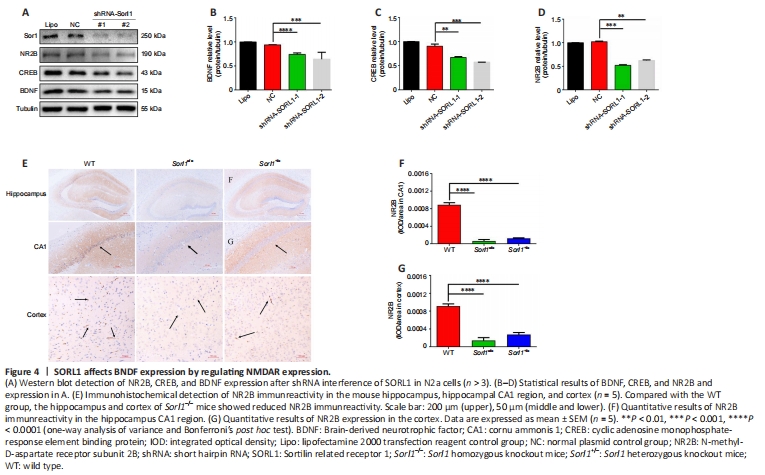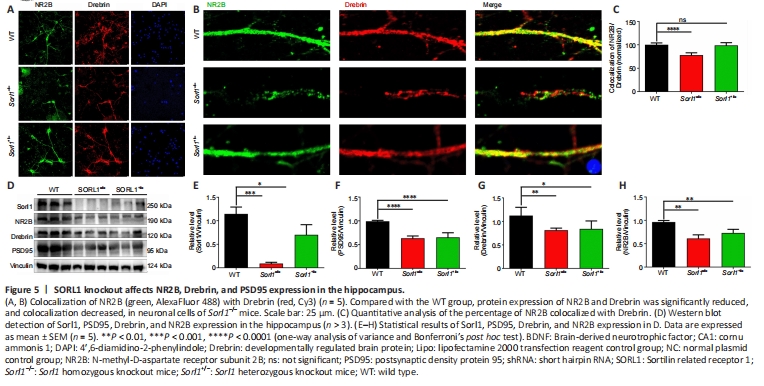神经退行性病
-
Figure 3|Immunohistochemical detection of Aβ and BDNF in the cortex and hippocampus of Sorl1–/– mice.

Sorl1 knockout may lead to AD pathology by affecting the transport of APP in endosomes/lysosomes without altering its process or expression. This suggests that the pathology of AD caused by Sorl1 knockout does not only depend on classical Aβ deposition. At an early stage of AD, SORL1 protein dysfunction may affect the transcription and expression of downstream molecules (Caglayan et al., 2014). We found Aβ deposition in the cortex and hippocampus of Sorl1–/– mice (Figure 3A–D), along with reduced BDNF expression (Figure 3A, B, E, and F). Therefore, the occurrence of AD caused by SORL1 is related to Aβ deposition and reduced expression of BDNF. Our findings suggest that SORL1 might affect learning and memory formation by regulating the expression of BDNF.
Figure 4|SORL1 affects BNDF expression by regulating NMDAR expression.

BDNF plays a critical role in synaptic plasticity and neuronal survival (Rohe et al., 2009). In Sorl1–/– mice, Aβ deposits affect BDNF expression (Zhu et al., 2022). A previous study found that BDNF can reduce Aβ deposition by increasing SORL1 expression, with BDNF being an upstream transcriptional regulator of SORL1 (Tanila, 2017). However, our study found that SORL1 also regulates BDNF expression. In N2a cells, after shRNA interference with Sorl1 (Additional Figure 2 and Additional Table 1), BDNF expression was significantly downregulated (Figure 4A and B). A previous study found that NMDA receptors (NMDAR) can regulate BDNF expression by turning CREB on/off (Lian et al., 2021). In the shRNA-Sorl1 cell model, we found reduced levels of NR2B and CREB expression (Figure 4A, C, and D). In the hippocampus and cortex of Sorl1–/– mice, NR2B expression was also significantly downregulated (Figure 4E–G). Together, this suggests that SORL1 may regulate BDNF expression by controlling NR2B expression, and participating in the occurrence and development of AD.
Figure 5|SORL1 knockout affects NR2B, Drebrin, and PSD95 expression in the hippocampus.

Compared with Sorl1WT mice, the number of normal neurons was significantly reduced in Sorl1–/– mice (Figure 5A). Some of the neurons in Sorl1–/– mice lacked neurofilaments, and the expression of NR2B and DRP was significantly reduced, resulting in decreased colocalization (Figure 5B and C). These results suggest that loss of SORL1 can lead to reduced NMDAR expression and neuronal damage.
Western blot analysis of mouse hippocampal tissue revealed a significant reduction in protein expression of NR2B, DRP, PSD95, and BDNF (Figure 5D–H). These findings suggest that SORL1 knockout may alter the expression of NMDA receptors, as well as the expression of synaptic-related proteins, leading to neuronal damage and abnormal function, thereby causing memory impairment in mice.